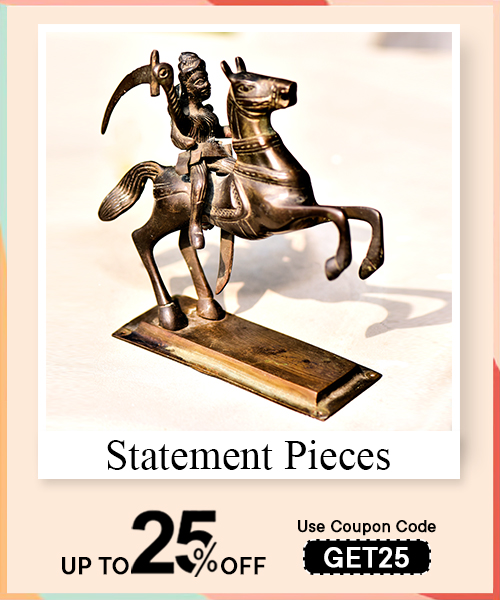A Warli painting is a folk memory sketched in white against the earthy backdrop of tribal life. Originating from the Warli tribe of Maharashtra, this visual tradition dates back to 2500 BCE, rooted in rituals, daily life, and the celebration of nature. It’s drawn not with brushes dipped in fancy paints but with rice paste and bamboo sticks, on mud walls or cow-dung-coated surfaces.
What sets Warli apart is its simplicity that transcends time, its use of basic geometric forms: circles for the sun and moon, triangles for mountains and trees, and squares as sacred enclosures, called chauk or chaukat. These shapes come together to form lively narratives of farming, hunting, marriage rituals, and festivals. But there’s no obsession with detail; it’s the essence that matters. It’s the rhythm of life portrayed in dance, in celebration, in community.
Despite being monochromatic, Warli is never dull. It’s alive. The stick-like human and animal figures form harmonious circles, evoking movement and unity, reminding us that life, however modest, is full of purpose and spirit.
What’s beautiful about Warli is that it never chases modernity. It observes it. It documents without judgement. It’s a living archive of a world where the human and the natural co-exist, not in conflict, but in conversation. It tells us that tradition doesn’t need to be grand to be powerful. Sometimes, it just needs to be honest.
Warli is famous not because it dazzles with color or screams for attention, it’s famous because it speaks softly, and yet leaves echoes. This tribal art from Maharashtra is celebrated for its storytelling, the kind that is inherited, not invented. At its heart, Warli is a celebration of life, but not the individualistic, loud kind of life. It’s the collective life, the village, the harvest, the rituals, the shared joy, the shared grief.
One of Warli’s most iconic elements is the tarpa dance, often depicted in circular patterns, villagers dancing in unison around the tarpa player, symbolizing the cycle of life. It’s in this very circle that Warli finds its rhythm, its pulse. Warli is also famous for how it collapses the space between art and function. It’s not just for galleries, it lives on hut walls, comes alive during festivals, and becomes part of marriage rituals and seasonal changes.
It’s this inseparability from daily life that makes Warli famous. It wasn’t created to be consumed. It was created to be lived with. Over time, as the world leaned into modernity, Warli stayed grounded. Yet it found its way into contemporary spaces, from textiles to installations, without losing its soul.
Read More : The Art of Glass Painting: Techniques, History, and Styles
In a world that often glorifies the complex, Warli reminds us of the elegance in the elemental. It’s famous for its minimalism with meaning, its rustic poetry. It teaches us that fame can be quiet, yet deeply rooted, like the tree that doesn’t shout, but shelters many.
The symbols in Warli art are not ornamental, they are foundational. Each shape, each motif, each figure carries meaning that’s been passed down generations, whispered rather than taught. At the core of Warli symbolism are three geometric forms ,circle, triangle, and square. Simple, yet powerful.
The circle represents celestial bodies, the sun and the moon, reminding us of the cycles we live by. The triangle is derived from nature, sharp like the mountains, strong like trees. The square, known as the chauk, is man-made, sacred, and often at the center of rituals. Within it, the goddess Palaghata, the goddess of fertility, is sometimes drawn, especially during wedding rituals.
Human figures are formed with two joined triangles, the balance between body and spirit, between masculine and feminine. The tarpa dance, often shown in a circle, symbolizes community and continuity. Then there are scenes of hunting, fishing, farming, and celebration, where animals, trees, and musical instruments join the symbolic parade.
Even daily tools, like sickles, baskets, ploughs, are drawn with reverence. They’re not mere objects; they’re extensions of life itself. Peacocks, cows, snakes, and birds appear often, not for decoration, but because they share the same world as the Warli people.
Each Warli symbol is an echo of belief, of reverence, of simplicity. It’s not abstract for the sake of style, it’s abstract because life itself, in its purest form, doesn’t need embellishment. The Warli language is drawn, not spoken, and its symbols are its oldest words.
At the heart of Warli paintings lies a deep reverence for nature and community life. These artworks are visual stories that celebrate the everyday, the rhythm of rural living, the harvest cycle, rituals, and harmonious coexistence with nature. There's no divine grandeur or royal court here, only the pure essence of life. Warli art frames human connection in the simplest lines and forms, echoing themes of birth, marriage, festivals, and the unity of the tribe. Each painting speaks silently of sustainability and belonging. It’s not just about art, it’s about remembering how close we once lived to the earth and to each other.
Warli painting is ancient, older than many forms that dominate galleries today. Its roots trace back to around 2500 BCE, placing it in the timeline of the earliest known human expressions. Passed down orally, this tribal art form from Maharashtra survived not in temples or museums, but on the walls of mud huts. The legacy of Warli is not written, it’s lived. It’s as if the art breathes through generations, whispering the stories of ancestors and seasons. Though its official documentation started in the 1970s, the soul of Warli stretches through centuries, untouched, holding the memory of a time when art and life were one.
Warli art is an exercise in minimalism and contrast. Traditionally, it is painted in white pigment on red ochre or mud-brown walls. The white pigment is made from a rice paste mixed with water and gum, echoing the region’s agricultural roots. This limited palette doesn’t restrict its expression, it sharpens it. The absence of multiple colours draws attention to the movement, the rhythm, the pattern of the story being told. White on brown is not just aesthetic, it is symbolic, earthy, and grounded. It allows the figures to emerge like ghosts from memory, marking time and tradition with quiet elegance.
You recognize Warli art not by its intricacy but by its simplicity, raw, rhythmic, and symbolic. Look for monochrome compositions filled with human and animal figures shaped in triangles, circles, and lines. The triangle represents balance; the circle symbolizes continuity. A central motif often appears, such as the “tarpa dance,” forming a spiral of celebration. There's no use of perspective or realism, it’s the essence that matters. Figures seem to dance, work, and live in a collective motion. The overall composition is flat yet full of life. Warli isn’t decorative, it’s declarative. It announces identity, belonging, and tradition through repetition and restraint.

Warli painting embraces a linear, symbolic, and narrative style, where the brushstroke feels like an extension of thought. It uses geometric shapes to represent the elements of life, triangles for humans and animals, circles for the sun and moon, and squares for sacred enclosures. The style leans into abstraction, avoiding perspective or proportions. Every composition is story-driven, often painted in horizontal bands like episodes in a folktale. There’s a ritualistic essence in the strokes, a deliberate simplicity that invites reflection. It’s not just art, it’s oral history in visual form, painted with intent, with rhythm, and a quiet, dignified soul.
Warli art is not just a painting style; it’s a visual language born from the soil. Deeply tied to the rhythms of tribal life, Warli art reflects the harmony between nature and human existence. It uses simple geometric forms, circles, triangles, and lines, to tell stories of farming, rituals, dances, and daily life. Warli is rooted in minimalism but speaks volumes about the community’s values, collective living, worship of nature, and ancestral traditions. In Indian culture, it holds a mirror to indigenous wisdom and a way of life that's timeless, making Warli both an aesthetic and a philosophical imprint of our folk heritage.
Read More : Kalighat Paintings in Modern Interiors: Home Decor & Cultural Fusion
The origin of Warli art traces back to the Warli tribe, residing mainly in the Sahyadri ranges of Maharashtra, especially in the Palghar district. This folk art dates back to at least 2500 BCE, making it one of the oldest tribal art forms in India. Initially created on the walls of mud huts using rice paste and bamboo sticks, Warli art served as a ritualistic expression during harvests, weddings, and funerals. It wasn’t made for decoration but for storytelling and spiritual connection. The art emerged from a need to preserve memory and pass down ancestral knowledge in the simplest, most honest form.
While Warli is primarily recognized as an art form, it crosses into the domain of craft through its practice and medium. Traditionally done on cow dung-treated walls using rice paste and natural dyes, Warli is a hands-on, tactile process, rooted in the handmade. It becomes a craft when applied to textiles, pottery, or household items, evolving with the artist’s touch. Craft, in essence, is the embodiment of tradition passed through generations, and Warli fits beautifully into that narrative. So yes, Warli is both an art and a craft, a bridge between storytelling and skill, between culture and creation.
Warli painting originates from Maharashtra, specifically from the tribal communities residing in and around the northern outskirts of Mumbai, particularly in the Palghar district. The Sahyadri hills are home to the Warli tribe, whose relationship with the land reflects deeply in their art. Though Maharashtra is its birthplace, Warli’s voice now echoes far beyond state lines. The state’s vibrant folk heritage finds a humble yet powerful representation in this form, which balances rustic life with profound symbolism. It’s Maharashtra’s tribute to the purity of simplicity, a canvas where the mundane becomes mystical.
Jivya Soma Mashe is celebrated as the father of modern Warli art. A member of the Warli tribe himself, he transformed this ritualistic practice into a widely recognized art form. Unlike traditional customs where Warli paintings were done only on special occasions, Jivya painted daily, using his art to speak to the world. His work carried emotion, movement, and life, elevating the art from symbolic to expressive. His contribution brought Warli into galleries, museums, and global attention. Yet, he remained rooted, his brush always dipped in memory, tradition, and the pulse of his people. He gave Warli its modern soul.
The primary color used in Warli art is white. This white pigment is traditionally made by mixing rice paste with water and a bit of gum for binding. Artists apply it on a red ochre or mud background, which is often prepared with cow dung and earth. This contrast creates a striking visual effect. The white doesn’t just serve as color; it becomes the soul of the painting. It gives form to their stories, stories of farming, festivals, daily routines, and the rhythm of rural life. Warli art doesn’t chase variety in color but depth in simplicity.
The core theme of Warli paintings is the celebration of life in its most organic form. Rooted deeply in nature and community, these artworks capture the everyday lives of the Warli tribe. You’ll find images of farming, harvesting, dancing, animals, and rituals. Everything is drawn in rhythmic patterns, often centered around a spiral or a circular motif, symbolizing the cycle of life. The art isn't ornamental, it narrates. It's a visual folklore passed through generations, depicting the bond between humans and nature. Through minimal lines, Warli captures the essence of joy, work, survival, and spiritual connection.
Among the most celebrated Warli artists is Jivya Soma Mashe, often credited with bringing this tribal art to the national and global stage. His works gave Warli paintings a new life, transforming them from ritualistic wall art into recognized forms of storytelling on paper and canvas. His style maintained tradition while introducing fluidity and motion. Besides him, his sons, Sadashiv Mashe and Balu Mashe, have also made significant contributions. These artists didn’t just paint, they preserved culture. Their work keeps Warli alive in modern spaces, reminding us of an indigenous wisdom that speaks through simple white lines.
Symbols in Warli painting act like a silent language, narrating the everyday life of the Warli tribe through visual rhythm. Each figure, a circle for the head, triangles for the body, and simple geometric forms, represents humans, animals, and natural elements. The sun, moon, trees, and hunting scenes are not decorative but symbolic of harmony between life and nature. These repeated motifs, drawn with precision, turn the mundane into the meaningful. The repetition becomes a loop of tradition, with symbols carrying memory, belief, and emotion. In essence, Warli uses symbols not just to depict, but to honor a way of living.
Traditionally, Warli art was painted on the walls of tribal homes using a mixture of cow dung and mud as the base. Today, with time and movement into modern spaces, artists commonly use handmade paper, canvas, or cloth. However, handmade paper is often preferred because its raw, textured surface mirrors the rustic feel of tribal walls. It absorbs the natural pigments well and allows the earthy tones to breathe. This shift in medium keeps the art accessible without losing its soul. The use of handmade paper is a bridge between the tradition of the tribe and the needs of contemporary presentation.
Yes, Warli painting is deeply handmade, not just in the act of painting, but in spirit and philosophy. It’s not mass-produced or mechanically replicated. Each figure is individually drawn by hand, echoing ancestral rhythms. Traditionally, artists used bamboo sticks as brushes and rice paste mixed with water as paint. Even now, when acrylics are sometimes used for durability, the essence remains untouched. The lines might not be mathematically perfect, but that is where the soul lies, in the small flaws, the human marks, and the careful repetition. Warli is less about the final product and more about the hand that remembers.
Modern Warli art is a graceful evolution of an ancient tradition. While it still holds the tribal heartbeat and signature forms, it now appears on canvases, home decor, fashion, and digital illustrations. The storytelling has expanded, from farming and festivals to climate change, gender roles, and city life. Artists blend traditional lines with new themes, creating a dialogue between the past and present. Despite the shift in subject, the texture remains minimalistic, symbolic, and rooted. Modern Warli doesn’t erase its ancestry, it adapts. It speaks of identity, belonging, and a culture learning to breathe in newer spaces without losing its voice.
The primary color used in Warli art is white. Originally made from rice flour mixed with water and natural adhesives, this white pigment was painted on mud-dung walls that gave a dark, earthy brown background. The contrast is striking, white on brown, symbolizing clarity in simplicity. Today, synthetic whites or acrylics might be used, but the spirit of contrast remains. The use of just one main color reinforces the minimalistic aesthetic and heightens the impact of each line, each figure. It’s not just a stylistic choice, but a visual philosophy: less color, more meaning. In Warli, white speaks volumes.
Warli painting uses a monochromatic style, traditionally drawn with white pigment on red ochre or mud walls. The technique involves basic geometric shapes, circles, triangles, and squares, symbolizing different elements of nature and life. Artists often use a bamboo stick chewed at the end to create a brush. The figures are drawn in repetitive patterns to depict community scenes like farming, dancing, or rituals. Warli painting doesn’t focus on perspective or depth; instead, it emphasizes rhythm, movement, and symbolism. Every form is deliberate, connecting storytelling with tribal wisdom and ancestral memory, using simplicity as a profound artistic device.
Warli painting stands as one of the most iconic art forms from Maharashtra, especially rooted in the tribal belt of the North Sahyadri Range. Among the most famous motifs is the "Tarpa Dance" , a circular pattern of human figures holding hands and dancing to the beat of the tarpa, a trumpet-like instrument. This dance signifies community bonding, celebration, and harmony with nature. It’s not just visually distinct but culturally symbolic, encapsulating the tribal philosophy of togetherness. This image, simple yet layered with meaning, has become synonymous with the identity of Warli art and Maharashtra’s folk tradition.
Traditionally, Warli art was painted on walls coated with cow dung and red mud. However, in contemporary practice, handmade paper, jute canvas, and recycled cardboard are commonly used. Brown or earthy-toned paper often replaces the red ochre background, while white pigment (a mix of rice paste and gum) mimics the tribal white. The texture of handmade paper complements the raw, earthy aesthetic of the form. Modern artists may also use acrylic on canvas, but to retain authenticity, many still prefer eco-friendly, naturally textured paper that reflects the rustic essence of Warli tradition and its connection with the earth.
The theory of Warli art lies in its spiritual connection to nature, community, and the cycle of life. It reflects the tribal worldview, where life and art are intertwined. It’s not decorative but ritualistic, often created during festivals, harvests, or weddings to invoke blessings. The minimal use of shapes, circles (sun/moon), triangles (trees/mountains), and squares (sacred enclosures), speaks to the balance between humans and nature. Unlike classical Indian art, Warli is narrative-driven, capturing the everyday with dignity and joy. It’s a visual philosophy that suggests harmony, sustainability, and collective identity through repetition, symbolism, and reverence for the ordinary.
Jivya Soma Mashe is the most renowned Warli artist, credited with transforming this tribal tradition into a globally respected art form. Born in 1934, he began painting Warli motifs beyond ritualistic boundaries, turning them into personal expressions. His work caught the attention of both Indian and international art circles. Mashe redefined Warli painting by preserving its essence while experimenting with themes. He received prestigious awards like the Padma Shri and was featured in exhibitions worldwide. His style maintained the tribal soul, community, rhythm, movement, but brought it to new canvases, preserving and evolving the Warli narrative for future generations.
Warli art dates back to around 2500 BCE, making it one of the oldest surviving tribal art forms in India. Though its widespread recognition came only in the 20th century, archaeological traces and the oral tradition confirm its ancient roots. For centuries, the Warli community used this art form during rituals and ceremonies, passing it down through generations without formal documentation. It wasn’t seen as "art" in the modern sense but as a sacred and communal practice. Despite modernization, the time-tested essence of Warli painting remains unchanged, deeply ritualistic, storytelling in form, and spiritual in intention.
Read More : How to Create Aesthetic Artwork: Tips, Materials, and Inspiration
Mandala art and Warli art differ in purpose, origin, and visual style. Mandalas, rooted in Buddhist and Hindu spiritual traditions, are circular geometric designs representing the universe, self, and cosmic order. They are meditative, inward-looking, and symbolic of spiritual balance. Warli art, on the other hand, is tribal, narrative-based, and outward-looking. It depicts social life, nature, and rituals through stick-like figures and simple geometry. While mandalas focus on symmetry and introspection, Warli is dynamic, community-centered, and grounded in earthy storytelling. Both honor tradition, but Mandala is spiritual geometry; Warli is the visual voice of tribal life.















